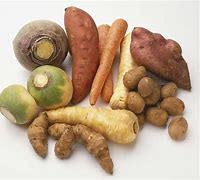Most root vegetables are nothing more than bulky fuel reserves. They allow plants to survive months of winter or dry-season dormancy in order to form seeds and reproduce. These roots become filled with complex carbohydrates, minerals and other nutrients. For thousands of years humans have harvested these storage organs as a vital source of food for survival.

FAST FACTS
Benefits and nutritional information:
Turnips, parsnips and rutabagas are high in fibre and low in calories.. All are good sources of calcium, potassium, vitamin B6 and folate, and excellent sources of dietary fibre and vitamin C.
- Turnips are grown not only for the edible root, but turnip greens are tasty and highly popular.
- Some sources claim that parsnips are a superfood, being superior to carrots in several vitamins and in fiber.
Starting:
- Root vegetables must be started from seeds sown directly into the soil.
- Plant seeds 1/2” deep one to two inches apart in rows 18 to 30 inches apart.
- Parsnip rows can be closer to 18” since the roots are smaller.
- Seeds spread out between layers of damp paper towel will have better and faster germination.
When to plant:
- Turnips can be planted either in the spring, as soon as the soil temperature reaches 40 degrees, or in late summer for fall or winter harvest. they do not like hot summer months.
- Note that an autumn crop, seeded in late summer, is usually sweeter and more tender than a spring crop—and pests are less of a problem.
- Turnips take 30 to 50 days to mature for harvest. Planting seeds at 3 week intervals can give a fairly constant harvest during the season.
- Due to its longer growing season — 80 to 100 days — rutabaga is generally only sown once, in mid-June to mid-July for fall harvest.
- Parsnips require a long growing season. They are typically ready to harvest 3 to 4 months after planting, depending on the variety.
Thinning, training
- Thin turnip and parsnip seedlings to a spacing of 3” to 6”, rutabagas an 8” spacing.
Signs of over-watering, nutrient deficiency
- Plants grown in wet soil are more vulnerable to root rot. You may wilted foliage first.
- Root vegetables grown with too much nitrogen can develop an unpleasant flavor. They do best with natural fertilizer containing potassium and phosphorous.
- They also use a number of micro-nutrients such as copper, zinc and manganese.
- Turnips and rutabagas may suffer from a deficiency of boron is the soil pH is above 6.
Pests and pest controls
- Root maggots feed on the developing roots. They burrow into the root and make it entirely unsuitable for food.
- Flea beetles chew small, round holes in leaves. They can spread disease and destroy the crop, especially when the plants are very young.
- Aphid infestations can drain the vigor from plants.
- A variety of diseases affects plants in this family, including Alternaria leaf spot, black rot, black leg and clubroot.
Harvesting
Turnips
- Harvest turnips when they reach a usable size, normally about two to three inches in width.
- Their shoulders are usually above the soil surface, so it is easy to tell how big they are.
- As the roots become larger, they are more likely to become bitter, strong-flavored, woody or fibrous.
- Spading the soil next to the plants will make them easier to pull.
- You can harvest the greens or “tops” of turnips and cook them as a savory vegetable.
- Cut the greens from the roots when you harvest the turnips, wash them and store separately.
- You can also use the greens when you thin crowded plants, before the roots begin to enlarge.
Rutabagas
- Leave rutabagas in the ground until September, October or even later.
- Frost improves best flavor, so many gardeners wait until after at least one hard frost to dig them up.
- The roots can be quite large. Rather than trying to pull them up, it is best to dig them with a spading fork.
Parsnips
- The most delicious parsnips are those which are left in the ground to be heavily frosted in winter.
- The extreme cold converts much of the starch into sugars to make them even more delicious.
- In cool temperate regions like ours, the roots are best stored in the ground during winter to be pulled as required.
